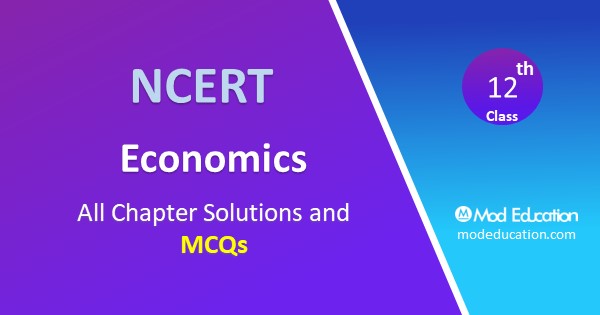MCQ Questions for Class 12 Economics Chapter 8: Class 12 Chapter 8 “Infrastructure” MCQ Questions for Class 12 Economics with Answers PDF Free Download here according to the latest CBSE syllabus and NCERT curriculum.

MCQ Questions for Class 12 Economics Chapter 8 Infrastructure with PDF
Here CBSE RBSE and Other State Board NCERT Objective MCQ Questions of Class 12 Economics Chapter 8 “Infrastructure” with Answers Pdf will guide students to do a quick revision for all chapter.
Question 1. Which of the following is a non-conventional source of energy?
(i) Hydroelectricity
(ii) Thermal Power
(iii) Solar Energy
(iv) Atomic power
(iii) Solar Energy
Question 2. What is morbidity?
(i) Proneness to fall ill
(ii) High infant mortality rate
(iii) High maternal mortality rate
(iv) Low life expectancy
(i) Proneness to fall ill
Question 3. The power generated from water is called
(i) Thermal Power
(ii) Hydroelectric Power
(iii) Atomic Power
(iv) Tidal Power
(ii) Hydroelectric Power
Question 4. Which of the following countries invest almost 50 percent of its GDP in infrastructure?
(i) India
(ii) China
(iii) Pakistan
(iv) Sri Lanka
(ii) China
Question 5. From which of the following sources of generation we get the largest amount of power?
(i) Thermal Power
(ii) Hydroelectric Power
(iii) Atomic Power
(iv) Tidal Power
(i) Thermal Power
Question 6. Which of the following statements is true for commercial sources of energy?
(i) Commercial sources are bought and sold.
(ii) Commercial sources are renewable.
(iii) Commercial sources are found in forests.
(iv) Dried dung is an example of a commercial source of energy.
(i) Commercial sources are bought and sold.
Question 7. Which of the following facilities is included in social infrastructure?
(i) Roads and highways
(ii) Housing
(iii) Internet
(iv) Electricity
(ii) Housing
Question 8. Which of the following sector was the largest consumer of commercial energy in 1953-54?
(i) Households
(ii) Transport
(iii) Industries
(iv) Agriculture
(ii) Transport
Question 9. What is morbidity?
(i) Proneness to fall ill
(ii) High infant mortality rate
(iii) High maternal mortality rate
(iv) Low life expectancy
(i) Proneness to fall ill
Question 10. Which of the following is not a function of primary health care?
(i) Spreading education concerning prevailing health problems
(ii) Promoting food supply and proper nutrition
(iii) Conducting research
(iv) Providing essential drugs
(iii) Conducting research
Question 11. Which of the following sector was the largest consumer of commercial energy in 1953-54?
(i) Households
(ii) Transport
(iii) Industries
(iv) Agriculture
(ii) Transport
Question 12. Which of the following systems is not included in the Indian System of Medicines?
(i) Allopathy
(ii) Homeopathy
(iii) Naturopathy
(iv) Ayurveda
(i) Allopathy
Question 13. Low-income countries do not invest in which of the given infrastructural services?
(i) Transport
(ii) Irrigation
(iii) Power
(iv) Telecommunication
(iv) Telecommunication
More MCQ Questions for Class 12 Economics Chapter 8 Infrastructure with Answer
Q1. Which of the following statements is not correct with regards to infrastructure?
(A) Infrastructure contributes to economic development.
(B) Infrastructure provides support services.
(C) All infrastructural facilities have a direct impact on the production of goods and services.
(D) Inadequate infrastructure can have multiple adverse effects on health.
(C) All infrastructural facilities have a direct impact on the production of goods and services.
Q2. Which of the following facilities is included in social infrastructure?
(A) Roads and highways
(B) Housing
(C) Internet
(D) Electricity
(B) Housing
Q3. What is morbidity?
(A) Proneness to fall ill
(B) High infant mortality rate
(C) High maternal mortality rate
(D) Low life expectancy
(A) Proneness to fall ill
Q4. What percent of rural households use bio-fuels for cooking?
(A) 50 percent
(B) 75 percent
(C) 80 percent
(D) 90 percent
(D) 90 percent
Q5. Which of the following countries invest almost 50 percent of its GDP in infrastructure?
(A) India
(B) China
(C) Pakistan
(D) Sri Lanka
(B) China
Q6. Low-income countries do not invest in which of the given infrastructural services?
(A) Transport
(B) Irrigation
(C) Power
(D) Telecommunication
(D) Telecommunication
Q7. Which of the following statements is true for commercial sources of energy?
(A) Commercial sources are bought and sold.
(B) Commercial sources are renewable.
(C) Commercial sources are found in forests.
(D) Dried dung is an example of a commercial source of energy.
(A) Commercial sources are bought and sold.
Q8. Which of the following sector was the largest consumer of commercial energy in 1953-54?
(A) Households
(B) Transport
(C) Industries
(D) Agriculture
(B) Transport
Q9. Which of the following is not a function of primary health care?
(A) Spreading education concerning prevailing health problems
(B) Promoting food supply and proper nutrition
(C) Conducting research
(D) Providing essential drugs
(C) Conducting research
Q10. Which of the following systems is not included in the Indian System of Medicines?
(A) Allopathy
(B) Homeopathy
(C) Naturopathy
(D) Ayurveda
(A) Allopathy
Q11. Infrastructure associated with energy, transportation, and communication is included in the ______ infrastructure.
social
Q12. ______ and safety hazards connected to transportation affect morbidity.
Air pollution
Q13. Inadequate infrastructure can have multiple adverse effects on ________
health
Q14. Agriculture considerably depends on the adequate expansion and development of ______ facilities.
irrigation
Q15. ______ accounts for the largest share in the commercial energy consumption in India.
Coal
Q16. Hydel and wind power do not rely on _________
fossil fuel
Q17. ________ sources of energy are found in nature/forests.
Non-commercial
Q18. The hospitals at the village level are known as ________
PHCs
Q19. _________ has huge potential because they are effective, safe, and inexpensive.
ISM (Indian System of Medicine)
Q20. Accessibility and _________ need to be integrated in our basic health infrastructure in order to provide basic healthcare to all.
affordability
Q21. Both economic and social infrastructures are essential for the development of a country.
True
